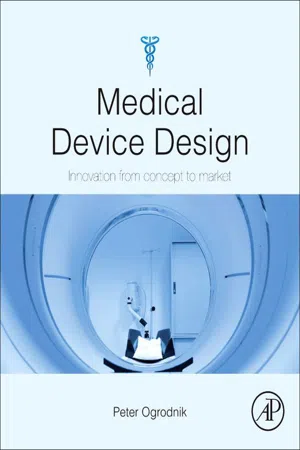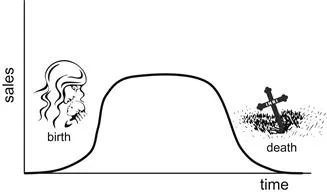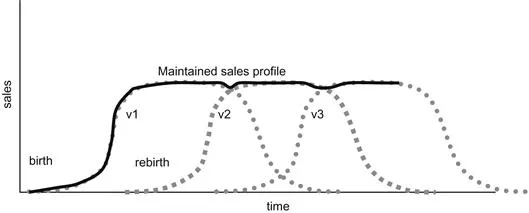In most people’s vocabularies, design means veneer. It’s interior decorating. It’s the fabric of the curtains or the sofa. But to me, nothing could be further from the meaning of design. Design is the fundamental soul of a human-made creation that ends up expressing itself in successive outer layers of the product or service.
1.1 What Is Design?
The word “design” causes confusion in every circle of life. One can use “design” as a noun (“This is my design”), as a verb (“I am designing”), and even worse, as a question (“Are you the designer?”).
“Design” comes from the Latin designare which means “to mark out, point out, describe, contrive.” Its form as a noun is the source of a common misconception: “it is a design” is normally attributed to a pattern or an image. If you stop an average person in the street and ask them to describe a designer, they are more likely to talk about wallpaper, clothes, hats or tableware than someone who designs, say, a total hip replacement. In this text we are more concerned with the verb “to design”: the act of designing, the act of contriving and communicating the contrivance. The phrase “to design” is very important. It suggests some formality, some structure, and some rigor.
We recognize a contrivance as a product: something we are going to sell to someone else. In this sense the product could be an item, a piece of software, or a service. Practically, it is virtually impossible “to design” something that is not intended to be useful to someone. Indeed, being able to design is what makes humans so … so human. We are able to manipulate our surroundings to make them better for us, and we can do some pretty wonderful things with items that are, inherently, rocks and trees. Hence, I propose, that designing is in our blood…it comes as second nature to the human race. But as with other things we humans do, some of us are naturally good at it and some of us are not.
It is a common tendency for us to “hack” – that is, we undertake the activity without any plan or thought. Hence we hack at the problem, just like hacking at an overgrown bush with an axe. Hacking achieves an outcome, but that outcome is always pretty awful and wastes loads of energy. Hacking is also an illegal activity associated with breaking into high-security computer systems; so, to coin a phrase, “neither hack nor a hacker be.”1 The aim of the phrase “to design” is, therefore, a reminder to us all that we need to plan and think about the problem before we start, and definitely not “hack.”
So, what are we to deduce from the paragraphs above? Firstly, design is a creative activity – it always ends with something new. On its own, however, this is not design – it could also be a work of art or the breaking of a world record. Hence we need to add something else. That something else is a demand, or a need – someone, somewhere wants this thing. Again this could still be a work of art or a new world record. We still need to add one other thing: a planned structure, a route map, or a planned process. This now discriminates the activity from all others. If you design an artifact properly, someone somewhere will definitely like it and it will be sold. And this is why the word “design” is often confused with the arts – it is a creative process. But creativity without structure is not design. As designers we need to harness our creative juices, stimulate every analytical fiber in our bodies, and use every one of our senses to detect opportunities. But we need to do this within an overall structure to ensure that the final outcome meets “a need.”
It is clear that we now need to define the need as this seems to be core to any design activity – and so it is. Design is about producing something that someone wants. They may not know they want it, but they do want it. How many times have you been to a clothes shop looking for a particular tie, blouse, or shirt? You will have a picture in your mind of what you want – that is your need. If the clothing designers have been clever they will have anticipated your need and you buy it. Normally, however, we walk from shop to shop and go home unhappy with something close, but not quite right. So many consumer goods are based on this “predictive” design process – the designers forecast what the consumer will need in, say, a year’s time (based on market research) and devise what the need will be, or even create a need through fashion trends (how many fashion shows and magazines are there?). Another example of this type of prospective need is when technology is rapidly developing and a brand new concept comes from nowhere, e.g. the Sony Walkman. This is often called disruptive technology (a new technology that completely changes the way things are done). The Walkman was a success because there was a brilliant forecast that the consumer would want this – but how many disruptive technologies wither on the vine? We do not hear about them because they failed – Sinclair C5 anyone?2
There is, of course, the immediate response to a demand from the consumer. This is synchronous or immediate need. This is where the designer is, physically, asked to develop a design based on a direct request. Classic examples of this are buildings – if you ask for your own house to be designed you will be working so close with the designer/architect that the information flow is, effectively, synchronous. This is the hardest to manage as the results are often needed immediately too.
The reverse process, retrospective or evolutionary need, is another name for evolutionary design. It is based on previous designs that may need improvement by implementing a small change. It is nearly always based on an existing concept but a small change makes it different, more desirable, or counteracts an issue. It is often based on customer feedback.
The final form is scavenging need. This is like watching vultures or carrion crows feeding on a dead animal. Here the need is not to produce something new but to produce something similar. This is often seen in the fashion industry and in consumer goods by those who follow but do not lead. This is commonly known as me too. It is said that imitation is the best form of flattery – one would rather be “the flattered” then “the flatterer.” It is, of course, intrinsically linked with copying and counterfeit.
Defining the need is, clearly, very important. We will be examining the need and how to articulate it in more detail in subsequent chapters. This may not seem to be a creative process, but it is. More often than not, this is the hardest part of the design process. It is hard because we need to understand the customer, fully. But, and this I can promise, if done properly the rest of the process will be so much easier.
So – is defining the need design? The previous paragraph should have pointed you to the fact that it is the start of the process. What follows next is the highly creative phase called ideas generation. We then have to select a winner from the plethora of ideas we have generated; and then we need the detail (or the embodiment). Only when that is done do we have the makings of a design. But, as we will see later, we have not finished, as we still need all of the other elements: packaging, instructions for use, etc., etc., etc. Only when all of this is complete do we have a design.
So, what is design? The simple answer is:
It is a process that takes a need and produces the solution that fulfills said need.
And, what is a design?
It is the solution.
Unfortunately we now come to the hard bit. We need to put all of the rhetoric into action; and as with most human activities it is easier said than done. The rest of this book is here to make this a lot easier for you.
1.2 The Design Life Cycle
People like to talk about the life of a design. To have a life means something has to be brought to life and then die; clearly this is a little too anthropomorphic for comfort. But the idea of a cycle is very important and the product’s “conception,” “birth,” and ultimate “end of life” are very pertinent to the designer. In the past the cycle was only concerned with the time to bring new versions to market (revision cycle). Nowadays we consider the whole cycle from manufacture to disposal for obvious environmental reasons. Hence we have two cycles to consider: revision cycle analysis and life cycle analysis. To avoid confusion between the old and the new, we will use these two terms from now on.
Revision cycle analysis is concerned with keeping products and services “up to date,” and this is usually reflected by sales figures. A classic bathtub curve describes this cycle (Figure 1.1). At the beginning a new design generates new interest and the sales grow. Eventually these sales plateau as market penetration is reached: consumers get bored, new competitors come along, or there is no one left to sell to. Hence this design’s life has ended. To carry on with this version would be silly to say the least. Hence designers need to plan revisions into the process to maintain the sales plateau (Figure 1.2). It is important to understand why a design is never finished … it goes on and on, continually improving, continually getting better. In quality management this is called a continual improvement process. It is clear that unless the designer is embedded into the discipline into which their design will reside all will fail. We must keep in touch with the end-user. We shall see, later, that postmarket surveillance is an essential part of this process.
Figure 1.1 The classic life cycle bathtub.
Figure 1.2 Sequential “bathtubs” maintaining the sales profile.
Life cycle analysis has grown in popularity since we all became aware of our environment. The days have gone when any designer can just ignore waste and the consequences of waste. Many products now must have carbon footprint assessments. But as designers we must all be aware of our effects on the environment; the medical devices industry is not immune from this requirement. We will see later that bringing together a design team enables waste to be minimized.


